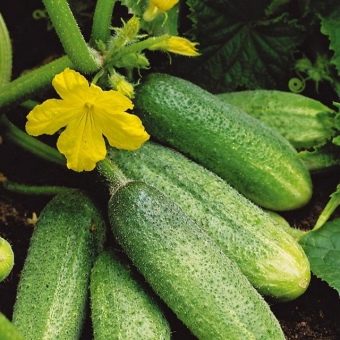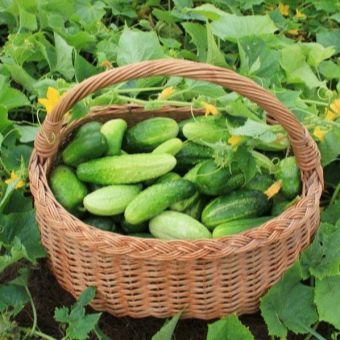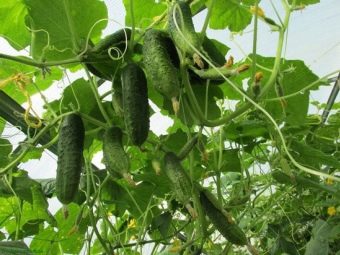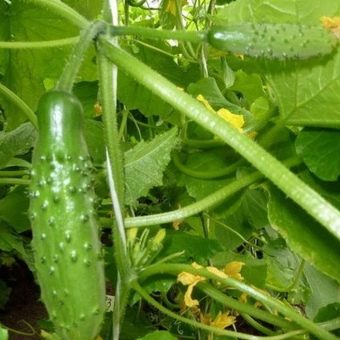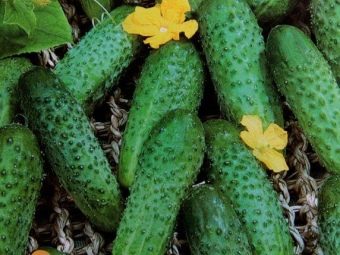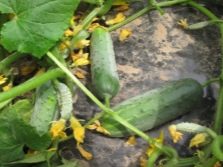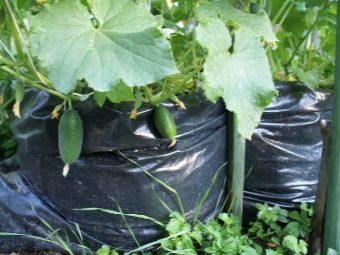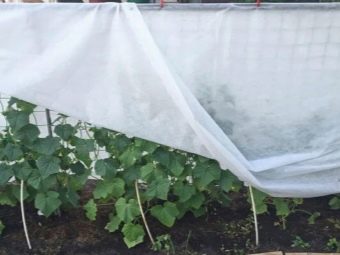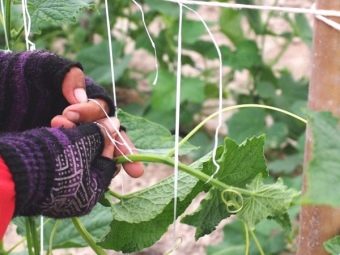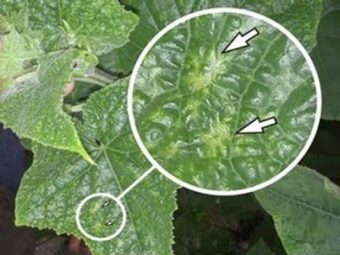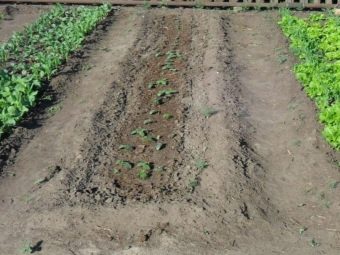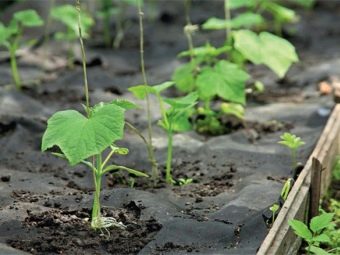Secrets of growing cucumbers in the open field

Cucumber is one of the most popular and sought-after vegetables, the cultivation of which requires tremendous effort. It will be possible to get a good harvest only if you strictly follow the recommendations and rules of experienced gardeners, who through trial and error determined the best ways to produce this vegetable.
General information
In order to grow cucumbers in the open field, it is necessary to choose the right varieties and species that will be resistant to most local diseases. Among the most common are powdery mildew and peronosporosis, which cause significant damage to the crop and can destroy all crops. Novice gardeners are best to choose for a long time known and proven varieties that are reliable in terms of resistance to various diseases.
In this case, you can pay attention to modern varieties and hybrids, which can boast excellent maturation and a fairly large crop.
In the process of choosing the best grade, it is necessary to take into account not only personal preferences, but also soil features, climatic conditions and other local indicators.
How to choose a grade?
In the modern world it is quite difficult to meet a person who would not like this vegetable. Most people do not represent their summer table without fresh salad, where the cucumber takes pride of place. In addition, who does not like to treat yourself to pickled gherkins in the winter season? Therefore, any owner of a small suburban area will certainly plant cucumbers in his house in order to get a high-quality and tasty product. However, everyone has different tastes and preferences.
Someone chooses only salad options, and some want special cucumbers for pickling. Experienced gardeners usually have several varieties that have already been tested by time and have proven their effectiveness. However, you must always be ready to conduct experiments, because only in this case you can choose the most optimal option for yourself.
It should be noted that beginners usually get lost in a huge assortment of cucumber varieties and cannot find the most suitable one for themselves. Despite the huge diversity, we can distinguish special groups, which, depending on their characteristics, allow you to purchase the desired variety. Like other vegetable crops, cucumbers can be divided by planting time. In the modern market there are both early and late varieties. Depending on the time of planting, you can get a crop at the beginning or in the middle of summer. As for the late Zelentsov, they will have to wait for their ripening until the end of August.
In addition, this type of vegetable can be divided depending on the method of pollination. Varieties are parthenocarpic, self-pollinating and bee-pollinating. The first two options will be an excellent solution for growing in polycarbonate greenhouses or film shelters. But the last option boasts a unique taste and is perfect for growing outdoors.
Among experienced summer residents, varieties that are designed to use cucumbers in natural form are also in great demand. This variety is called lettuce and is usually characterized by elongated fruits and fairly dense skin.
Due to its unique properties, such vegetables can be planted not only in the open air, but also in greenhouses. A distinctive feature of cucumbers is that they are fairly well preserved, but they are not suitable for preservation, since they become too soft under the influence of certain substances.
If it is necessary to preserve and obtain brine, it is best to give preference to special varieties that are distinguished by thick skin and dark spikes.The main advantage of such species is that they skip the brine without any problems, and the flesh is always distinguished by an impressive crunch.
A serious disadvantage of such varieties is that storing them without brine will not work for a long time, even if you use fast freezing for this purpose.
If gardeners can not decide for what purposes cucumbers will be used, then it is best to choose universal options. They at the same time can be used both in a natural form, and in canned. However, resorting to such a choice is only if you do not have enough space to simultaneously grow many different varieties of cucumbers.
The process of growing this vegetable in the dacha also has its own specific features of selection of the variety. If self-pollinated varieties should be preferred for greenhouses, as they are excellently coped without pollination, then for open beds the ideal solution is pee-pollinated varieties and hybrids, which are distinguished by brighter and richer flavor properties. Growing other cucumbers in an open area is not worth it, since most of the varieties can hardly cope with the sharp temperature changes that are inevitable in the garden.
Among the most popular and sought-after varieties among summer residents and gardeners, the following should be noted.
"Cascade"
Bee pollinating variety, which has an impressive yield and is versatile in use. The advantage of cucumbers of this kind is that they are characterized by unique taste and almost no bitter taste. "Cascade" should be used for planting in the open field - this variety is famous for resistance to water and cold temperatures.
"Amethyst"
A variety with early ripening, a feature of which is a high yield and resistance to pests. The main problem of most cucumbers is powdery mildew, which bypasses this type of side. And the finished product has a tuberous skin and unique taste properties. In addition, these cucumbers perfectly cope with transportation and can be used both in conservation and in natural form.
"Elegant"
Bee pollinating variety with high yield, which can be used fresh and in different blanks. According to reviews, green leaves have a size of about 10 cm and are covered with fine skin. The peculiarity of planting is that they are resistant to diseases, and also do an excellent job with olive spotting.
Due to the unique properties of this variety, it can be used not only for planting in open ground, but also for planting cucumbers in greenhouse conditions.
"Atlant"
Mid-season hybrid that can boast of operative maturation and incredibly smooth skin. It should be noted that in most cases such varieties are used for planting cucumbers in polycarbonate greenhouses, but it can also be used for open ground. The main advantage of this variety is that it is characterized by extremely high resistance to sudden temperature changes. At the same time, these cucumbers need a large amount of water and soil fertility. Sredneroslye bushes can boast an incredible resistance to diseases and pests, so that the yield is quite high.
"Moment"
Bee pollinating variety, which is characterized by an average maturity and has an impressive resistance to the effects of diseases and pathogens. Even after fungal infections, these cucumbers recover extremely quickly. Another advantage of the variety is its versatility, so that products can be stored for a long time without losing their appearance and taste.
In the process of growing cucumbers in the open field should pay attention to late-ripening varieties. One of the most popular and sought-after is Nezhinsky, which boasts medium-sized fruits. The peculiarity of this product is that it can be used in its natural form, as well as for processing. This result was achieved thanks to the delicious and incredibly crispy pulp. In addition, these varieties of cucumbers in a remarkable way resist fungal and other infections, and the harvest is quite large and high-quality.
If you are interested in late-ripening hybrid varieties, then it is best to pay attention to the “Samurai”, which is distinguished by perfectly branched bushes. In the field of consumption, the harvest is characterized by its versatility. The finished product has impressive marketable qualities. Like most other hybrid varieties, Samurai is extremely resistant to fungal diseases and microorganisms, especially powdery mildew. Despite the fact that this variety feels great in greenhouse conditions, it is possible to grow such a cucumber in an open area.
In recent years, the Kurazh variety has been very popular among summer residents who grow cucumbers in open conditions. This is an early hybrid that does not need to be pollinated by bees and feels great in the open air. Regardless of weather conditions, you can count on large yields. The peculiarity of these medium-sized plants is that they can easily deal with most diseases. Covered with small tubercles, cucumbers can boast amazing taste and perfect flesh, therefore they are suitable for both summer salads and winter preservation.
"Crane", which is a mid-early hybrid - a great option for growing in the open air. Such cucumbers need to be pollinated by bees and are characterized by impressive yields, and can also be used both in natural form and for brine. The variety is not affected by powdery mildew, so the yield is quite high. Externally, cucumbers are distinguished by small tubercles. It should be noted that the “Crane” needs enough water, because otherwise it will not grow.
Another suitable variety for cultivation in the open field is Hector, which is an ultra-early hybrid. It is distinguished by small bushes and abundant fruiting. Medium and large Zelentsy have enough tasty and crispy flesh. Among the main advantages of this sort can be distinguished its ability to cope with sudden temperature changes and resistance to peronosporosis. In terms of use, "Hector" is universal.
Landing methods
During the cultivation of cucumbers in an open area, close attention should be paid to their planting, because only this will determine the yield and other indicators. To date, allocated a huge number of ways of landing, but the most popular is only a few.
Every year gardeners try to create as much as possible suitable conditions for the cultivation of their favorite vegetableThat is why advanced technologies emerge almost every day that have proven their effectiveness and efficiency. Among the rather extravagant methods of planting cucumbers can be distinguished cultivation in a barrel, a bottle, as well as other similar containers.
A distinctive advantage of such methods is that they can be used not only for planting cucumbers in an open area, but also during their planting on the balcony, in greenhouse polycarbonate or in the country.
In bags
One of the most interesting and original options is planting this vegetable in bags.This method is very similar technology with the use of barrels. The peculiarity of the technique is that packages or bags of 100 and more liters are used as tare. Typically, gardeners for this purpose, use ordinary bags of sugar. They are filled with soil and manure, and it is recommended to use peat or humus.
If the bag is large, then dry grass or any other similar waste can be strewn onto the bottom. It should not be forgotten that the thickness of the soil can not be less than 15 cm. The place for bags must be as sunny as possible so that the crop gets enough sunlight and wind. You can install bags directly in the garden, propping them up with metal rods.
One of the main attributes of this method of growing cucumbers on open ground is the use of special tubes that are inserted into bags. Their length is usually about 100 mm and they are used to deliver to the water in the soil. The presence of through holes allows you to supply water from start to finish. Depending on the size of the bag and the cucumbers used, about 15 seeds can be planted in one container. After forming a few leaves erupt and remain the strongest.
Among the advantages of growing cucumbers in the open field with the use of bags are the following points.
- Ability to save space on the site. Due to the small size of the bag and the ability to receive several bushes from each of them, the final yield will be much higher than with the usual method of cultivation.
- No need to carry out digging and weeding.
- Easy care bed.
- Fruits turn out pure, and at a large number of rains they are reliably protected from damage.
A significant disadvantage of this method of planting cucumbers is that it will be necessary to spend quite a lot of money on the creation of vertical beds.
In addition, it is constantly necessary to control the level of soil moisture, because without this it is impossible to get a good harvest.
In a hut
The second most popular landing technology is landing in a hut. The peculiarity of this method is to drive in the center of the pipe so that 1 m is underground. During the planting of seeds, one must be extremely attentive and clearly monitor the interval, which can not be less than 30 centimeters. After the sprouts reach 15 cm, it is necessary to fix the cord at the very top, thus forming a trellis. It is for him and will crawl lash. Using this method allows you to grow a rather tall bush, but it will not be able to boast of compact size. That is why it will be necessary to pay close attention to its permanent molding.
The following strengths of this growing method can be highlighted:
- economical allocation of free space, which is especially important with limited land resources;
- protection of fruits from contamination, which completely eliminates the possibility of their rotting;
- due to their high size, these plants are the decoration of the garden and play the role of shading for other plants, which may cause significant damage to the excess sunlight.
It should be noted that there are almost no flaws in such an organization. The only difficult point is that initially it is necessary to work on the creation of such a support structure. In addition, bushes in such conditions grow rather slowly, especially if they are planted on the north side, as they will not receive the necessary amount of sunlight.
In tires
In recent years, planting cucumbers in car tires has been very popular.This technology boasts its originality and compactness, as well as the ability to create a rather extravagant design of the beds. The process of creating such a structure is to put about 5 or more tires on each other and fill them first with various wastes and then with soil and peat. As in the case of bags, close attention needs to be paid to creating a pipe that will be used to water the structure. This is extremely important, because without enough moisture, any sort of cucumber is doomed to death.
Among the main strengths of planting cucumbers in car tires on open ground are the following:
- the opportunity to significantly save space on the bed, which is especially important with limited space;
- cell mobility and its attractive design;
- the opportunity to plant cucumbers and get the harvest 2 times for 1 season, which significantly increases the amount of the product obtained.
Of course, before landing, you will have to work hard to create such a structure and provide it with an attractive appearance. In addition, you will need to find tires. It should be noted that it may not be new store tires, but already used old versions. The performance properties of tires have no role in the process of growing cucumbers in them. As for the soil used, it should only be loose and light, otherwise it will not be able to be watered, and as a result the crop will be spoiled.
On willow twigs
One of the most ancient ways is to grow this vegetable culture on willow twigs. The essence of this method is to build a fence of willow twigs. The main advantage of this material is its impressive flexibility, so that when in contact with it, cucumbers feel quite comfortable and cozy. In the process of planting it is necessary to be extremely careful that the binding does not turn out to be too dense. Otherwise, cucumber seeds will not be able to receive the proper level of light and air, which will affect the growth rate and taste of the product. One of the advantages of this method is the ability to economically spend space under the garden, as well as reduce the risk of infections on fruits.
In addition, willow branches allow you to create diffused light, which prevents the burning of the fruit due to too strong sunlight and hot weather. Due to this property, neighboring cultures with cucumbers are always in a slightly shaded place, which also has a positive effect on their growth.
The main disadvantage of this technique is that much attention needs to be paid to the procurement of materials, and the process of working on the bed is quite laborious.
Under the film
If you are looking for an extravagant and effective way, then planting cucumbers under film is exactly what you need. The use of such shelters on productive beds allows you to get high-quality and tasty fruits. It is a polyethylene film or a special fiber that is excellent for such purposes. Among the main advantages of this technology, we can highlight the ability to provide good light and warm irrigation with water. In addition, for the harvest will have to use phosphate fertilizers, as well as carry out careful maintenance.
This method of planting seeds requires maximum concentration and responsibility. They can be planted only if the temperature does not exceed 23 degrees, and it is necessary to cover with a film only after watering the beds. The edges of the film on all sides are attached to the ground as much as possible with the help of bricks or other possible fasteners. Only then will it be possible to create the most optimal conditions for planting cucumbers.
After the shoots have appeared, the bed should open during the day, but at night the material is tightly covered to ensure reliable protection of the crop from temperature extremes and bad weather conditions. It should be remembered that night frosts can be even in May, so an unprotected crop may die immediately. In addition, this protection provides reliable protection from rotting due to heavy rain.
In large bottles
Of course, there is still a huge number of other ways that are efficient and reliable. For example, the method of growing cucumbers in five-liter bottles is great for growing similar vegetables in regions with a harsh climate.
The peculiarity of this method is that it will not be necessary to transplant young shoots to greenhouse beds. And in order to obtain the highest quality yield, you must carefully prepare the mixture for containers, which includes soil, peat, fertilizer and wood ash. In addition, on the bottom you need to make a couple of holes so that you can water the plants.
In a barrel
Growing cucumbers in a barrel involves the use of huge containers that will be left on the site in any convenient manner. The main advantage of this technology is that you can significantly save space, even grow cucumbers on a small courtyard in the country. And the quality of the barrels does not matter, so you can use both new and old versions.
The technique will be effective only if the strata are correctly formed in the barrel itself. First you need to drill a few holes in order to create a greenhouse effect. It is thanks to these holes that excess moisture will not linger in the soil and will be able to flow out. Otherwise, it will stagnate, causing the product to rot.
It is best to use the purchase of soil that is intended solely for cucumbers. If financial opportunities do not allow this, then it is necessary to prepare a similar soil with your own hands. To do this, the fertile soil is mixed with manure and humus, and then diluted with river sand. The latter point is especially important if the land used is of a dense structure.
Care rules
Cucumber is one of the most popular garden crops. Planting is a rather complicated process, but only half of the success depends on it. It will be possible to grow a high-quality and tasty crop only if close attention is paid to agricultural technicians.
Top dressing
Most people think that the more fertilizer they use, the more likely they are to get a good harvest. However, such an opinion is extremely erroneous, and can reduce all your efforts to nothing. It is worth remembering that feeding cucumbers is necessary in case the weather is too hot. The higher the temperature, the more attention should be paid to this process.
In no case can not grow cucumbers in the same place for several years. If open ground is used, it is best to replace white cucumber or cauliflower, which will allow the soil to rest and be ready for sowing for the next season. In addition, cucumbers feel great in areas where tomatoes, potatoes or sugar beets were previously grown.
The best fertilizer for cucumbers - ash, it contains a lot of nutrients. Mullein is good to use during fruiting. This will increase the yield. Another option - humus, which is found in every gardener.
Watering
Careful attention should be paid to watering plants, because they must receive the required amount of moisture. It is water that is the basis of growth, so with a lack of moisture Zelentsy are small and tasteless.
Pour cucumbers with warm water only, and pour it under the root. The best time for the procedure is early morning or evening. In cloudy weather, the culture is not watered, as the shoots do not absorb water. Before the cucumbers begin to bloom, supply water once a day. With the appearance of ovaries - 3-4 times a week.
When the fruits begin to ripen, it is enough to limit yourself to weekly watering.
Pruning
Properly done pruning will not only increase the amount of the harvest, but also change its quality for the better. The main advantage of pruning cucumbers is that the vegetative mass is significantly reduced, which has a positive effect on the growth of fruits.
The pruning method should be chosen depending on the plant variety. From time to time it is recommended to get rid of lateral stems and leaves in order to speed up the development of fruits.
They are pruning early in the morning. At the same time, not only diseased shoots and leaves are removed, but also those whips that cling to others.
Tying up
Properly carried out garter allows you to solve several problems, including saving space at the dacha, simpler harvesting and its protection from a variety of bacteria. Tying is best done when the height of this vegetable crop exceeds 30 cm. Today, there are two ways to tie the garter: horizontal and vertical.
The first method is quite simple. Two sticks are driven into the ground, and between them they stretch the rope in several rows. Young shoots allowed on the bottom edge.
The second method also uses supports, but the rope is stretched in one row. After some distances, cloth patches are fixed on it, their number should be equal to the number of cucumber bushes. The lower part of the flap is fixed on the bush.
Diseases and pests
Diseases
Cucumber affects a huge number of diseases and pests that can cause damage to the crop. In order to learn how to identify them and competently deal with them, it will be necessary to closely and closely monitor the condition of greenhouses.
One of the most common problems is powdery mildew, which is a serious disease. Among the main causes of the emergence of such a disease can be identified excessive humidity, poor ventilation, the use of cold water during irrigation and frequent temperature changes. Affected crops are characterized by minimal growing season, which greatly reduces the amount of crop. In most cases, fruiting cucumbers suffer from the disease.
The main symptom of the disease is the presence of round spots on adult fruits. If powdery mildew is present for a long time, then such raids will also be visible on the stems. A neglected disease usually causes the stems to dry completely and the crop becomes unusable. Most of all, this cucumber disease progresses in areas that are characterized by excessive air humidity.
First of all, you need to choose varieties of cucumbers, which are characterized by resistance to this disease. In the autumn season, it is necessary to get rid of all residues and carry out deep digging of the soil. If the infection has already happened, cucumbers will respond well to the treatment with nettle or soapy water. Among chemical products, Bordeaux liquid, Topaz, and Quadris will be an excellent solution.
The second most common disease is downy mildew, also called peronosporaz. This fungal infection is quite dangerous and can also destroy the entire crop, if not in time to cope with it.
In most cases, this vegetable becomes ill with it during flowering, and among the main symptoms of downy mildew, the following can be identified:
- angular, yellow-green oily spots appear on the upper part of the leaves;
- the lower part of the leaves is characterized by a violet bloom;
- in a short period of time, the spots grow quickly enough and soon occupy the entire leaf.
Remarkable is the fact that today there are no varieties of cucumbers and hybrids that are distinguished by their maximum resistance to downy mildew. That is why it is necessary to constantly inspect your crop and take appropriate measures when a similar disease is detected. It is advisable to treat it the same way as ordinary powdery mildew.
Another nuisance for gardeners who grow cucumbers in the open ground is olive spotting., which is also referred to as cladosporia. The peculiarity of this disease is that it damages not only the fruits, but also the stems. The cause of cladosporiosis is too high air humidity, as well as frequent temperature drops. But if cucumbers are grown in regions with high temperatures and low humidity, the disease is extremely rare and develops very slowly.
The main symptom of this disease is the presence of small ulcers on the stems and petioles. Already after a few weeks, the sick parts of the bushes begin to crumble and the disease spreads to other parts of the cucumbers. If no measures are taken in time, in a month the harvest can be completely destroyed by this disease.
Treat the disease by spraying Bordeaux liquid or copper oxychloride.
Root rot is a disease that afflicts adult cucumbers. Among the signs of such a disease can be identified the presence of yellow spots and sagging leaves. In addition, sometimes brown spots appear at the roots of the stems. Like the previous disease, root rot spreads extremely quickly in conditions of high humidity, therefore, upon detection, it is necessary to immediately stop watering the plants.
It should be noted that this disease can occur only on weak plants, therefore, to prevent the use of nitrogen fertilizers. It will be good to change the soil on which the cucumber grows. Fungicides must be added to the new land. Among the drugs can be noted "Trichodermin", "Baktofit", "Previkur."
Pests
As for cucumber pests, the first place in this list is occupied by the whitefly, which is the most dangerous for this plant. This insect is characterized by a length of 1 cm and two pairs of wings. To judge that the insect attacked your cucumber harvest, you can by a large number of bright spots on the leaves of cucumbers. In addition, from the bottom side very often colonies of small white insects appear, due to which very soon the harvest begins to turn completely yellow, and the leaves fall.
To protect your crop from the whitefly, it is necessary to annually treat the soil with the help of fertilizers and disinfect. In addition, choose the best quality planting material, because the ability of plants to resist pests depends on it. If it was not possible to save cucumbers from the invasion of these pests, then the plant will need to be sprayed with soapy water, and the insects themselves should be caught by suction devices. There are also a huge number of chemicals that have shown their effectiveness in the fight against whitefly. Among the most common can be identified "Vertimek" and "Aktellik."
The spider mite is also a rather unpleasant parasite. It is difficult to make out, but you can always see a thin cobweb with which he twines the leaves. All diseased leaves are quickly collected and burned. Plants are treated with insecticides, and also necessarily sprayed with a solution of "Karbofos." For tick prevention, it is necessary to plant the seedlings early and in time to uproot the weeds.
Often affects cucumbers and melon aphids - a tiny insect parasitizing on the lower part of the foliage.Winter pest spends in the humus and weeds, so all this should be removed before the cold.
Insecticides will help in the fight, but ladybirds will be especially good, they will quickly cope with uninvited guests.
Recommendations
Thus, cucumbers are one of the most common crops in modern horticulture. In order for the harvest to be of the highest quality and tasty, it is necessary to pay close attention to all aspects of cultivation.
First of all, choose a high-quality place for planting seeds, which should be characterized by excellent illumination. If you follow all the recommendations of professional summer residents, in the next three months you can get a good harvest. And in the process of choosing varieties, it is best to give preference to those that are distinguished by good resistance to the effects of diseases and pests. To allocate a cucumber planting need a bed with good tinted soil, which receives the required amount of sunlight. When preparing seedlings at home, be sure to engage in hardening and disinfection of seeds.
Proper care - the most important stage of cultivation. If there is not enough water, then there is every chance for the fruit to grow bitter. That is why it is recommended to constantly maintain the level of soil moisture when watering the plants. Feeding cucumbers should be carried out every month, and you can use for this purpose compost, a hall and a mullein.
In order to prevent the invasion of insects, it is necessary to consider the harvest on an ongoing basis and immediately take measures to eliminate them if any problems are detected. Otherwise, some diseases and insects can destroy the crop in a week and negate all the efforts to grow it. If you are going to use insecticides, it is best to first limit yourself to folk remedies or choose the least toxic options. Of course, these funds are not very efficient, but they do not allow spoilage of cucumbers.
It is best to plant seeds on seedlings using separate containers. Seedlings can be planted only after there is no threat of frost. It is necessary to take into account not only daytime temperatures, but evening and nighttime temperatures, since most of the seeds die because of night frosts, which may even be in April. Thus, the seedlings should be transplanted in May. Between plants it is necessary to maintain a distance of at least 15 cm, which will allow to get large greens.
After ripe cucumbers reach a certain size, it is necessary to collect the product at least once every few days. It is impossible for the cucumbers to turn yellow on the plot, as they will begin to take away strength from other fruits that have not yet ripened.
When choosing a variety, it is necessary to take into account the particular terrain. For example, for the Urals or Kuban, different varieties are needed, given the climatic situation in the regions. In addition, attention should be paid to hydroponics, regardless of whether the fit is carried out in bags, buckets or car tires.
If you want your crops to grow well, you should take care of them step by step: fertilize, water, spud and monitor the condition of the leaves and fruits. Pruning and tying should be carried out strictly depending on the variety of cucumbers. Such secrets will help the house to grow a good crop of cucumbers, which will be different unusual and unique taste.
With all the subtleties of growing cucumbers, you can find in the next video.

